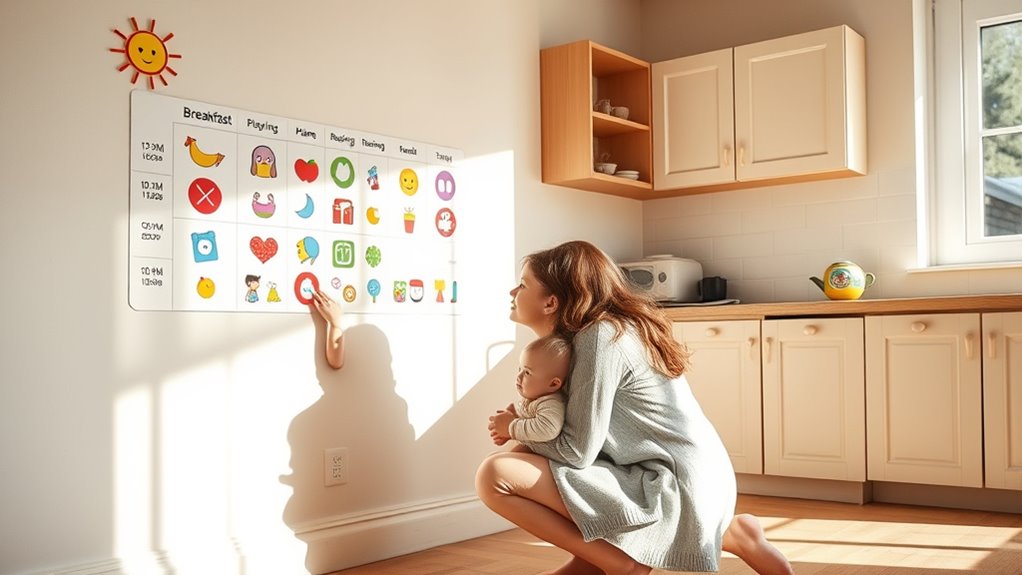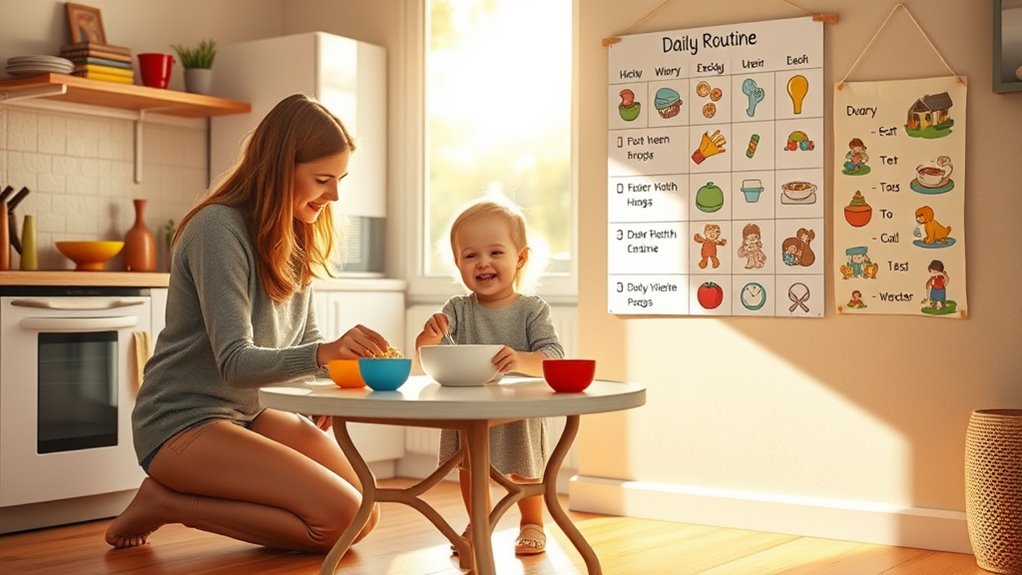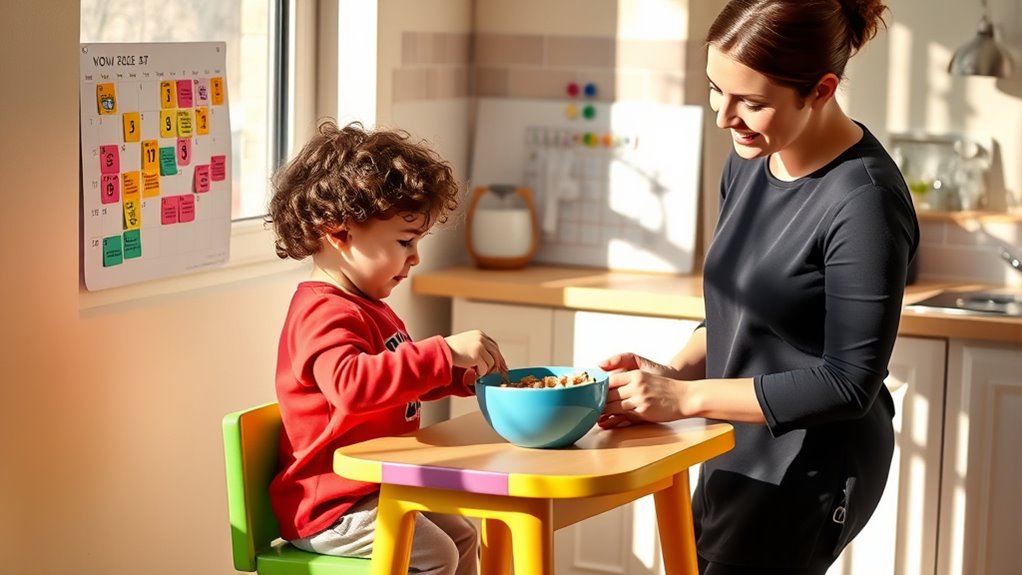Creating a consistent routine for your child is key to their emotional stability. By establishing predictable wake-up times, scheduled homework, and calming bedtime activities, you provide a sense of security. Visual schedules can enhance clarity, while involving your child in the planning allows them to feel empowered. Balancing flexibility with structure helps them adapt to changes. Celebrate their small successes to build confidence. Keep exploring how routines can boost your child’s development and well-being.
Key Takeaways
- Establish a consistent wake-up time to regulate your child’s body rhythm and promote healthy eating habits through a nutritious breakfast.
- Create a visual schedule with words and images to enhance understanding and engagement in daily routines.
- Involve your child in planning routines to provide choices and foster a sense of ownership and independence.
- Balance structure with flexibility, allowing your child to adapt routines as needed while maintaining core elements.
- Celebrate small successes to reinforce positive behavior and build your child’s confidence in following routines.
Understanding the Importance of Routines

While you might think routines are just a way to organize daily tasks, they actually play an essential role in your child’s emotional and psychological well-being. Routines provide a sense of safety and security, which helps reduce stress and anxiety. When you establish consistent patterns, your child learns to manage their emotions and behaviors more effectively. Developing a growth mindset through these routines encourages children to embrace challenges as opportunities for growth. Predictability gives them control over their environment, making daily situations less intimidating. Routines also boost cognitive development by instilling organizational skills and time management. For younger kids, predictable routines foster self-confidence and independence, while older children benefit from the stability routines provide during life changes. Moreover, establishing clear rules for children can enhance the effectiveness of these routines. Additionally, fostering emotional intelligence through routines can significantly improve your child’s interpersonal relationships and self-regulation skills.
In particular, maintaining consistent routines can be especially beneficial during times of transition, such as divorce, to help children feel more grounded.
Ultimately, these practices lay the foundation for healthier habits and better self-regulation in adulthood.
Key Elements of a Daily Routine

A successful daily routine for your child includes several key elements that contribute to their overall well-being and development.
Start with a consistent wake-up time to regulate their body’s rhythm, followed by dressing, grooming, and a nutritious breakfast to fuel their day. Incorporate morning activities like reading or simple exercises to stimulate their mind. Engaging in creative projects during these morning hours can also enhance their digital literacy, which is crucial for personal growth in today’s technology-driven world. Additionally, emotional reflections on daily activities can foster a deeper connection with their experiences.
Establish a consistent bedtime and calming pre-bed activities, such as storytelling, to prepare them for sleep. Scheduled meals encourage healthy eating habits, while mealtime provides an opportunity for family bonding.
Designate specific times for homework to enhance focus, and allow for breaks and rewards. Finally, include leisure time for free play and outdoor activities to support creativity and physical health. Additionally, consider implementing a bedtime routine to help your child transition smoothly into sleep.
Visual Schedules: A Helpful Tool

Creating a consistent routine for your child is enhanced by incorporating visual schedules, which serve as powerful tools for clarity and structure. These schedules outline daily activities clearly, fostering predictability and security.
By using a mix of words, symbols, and images tailored to your child’s literacy level, you can guide them through routines independently. Visual schedules also support language skills, helping kids grasp concepts of time like “later” or “next.” They encourage engagement and attention, making learning more effective. Including protein-rich breakfast options such as egg rollups can help your child start their day with energy.
To implement a visual schedule, make sure it’s visually appealing and easy to follow, and include a way for your child to mark completed tasks. This approach can greatly ease shifts and reduce anxiety around changes in routine. Additionally, incorporating healthy breakfast choices into your morning routine can set a positive tone for the day.
Involving Your Child in Routine Planning

How can you make your child feel more engaged in their daily routines? Involving your child in routine planning is key. Start by giving them choices within the routines, which boosts their motivation and sense of ownership.
Explain why each routine is important, helping them understand its value. Creating routine charts together, allowing them to visualize their day, can also reinforce the concept of critical periods in their development. Incorporate fun elements to make routines enjoyable, increasing their participation. Engaging in activities that promote emotional well-being can also enhance their overall routine experience. For instance, using playful communication techniques similar to seniors texting humor can make routine discussions more entertaining.
Flexibility is essential too; let your child adapt routines when necessary. This involvement not only fosters independence but also develops crucial life skills like decision-making. Additionally, teaching children about the importance of emotional well-being can further enhance their engagement in routines.
Ultimately, when your child helps shape their routines, they’re more likely to cooperate and embrace the structure you provide.
Balancing Realism and Expectations

Involving your child in routine planning sets the stage for balancing realism and expectations. By considering their age, temperament, and individual capabilities, you can establish realistic expectations that foster their independence. A structured routine provides predictability, creating emotional security and reducing anxiety. However, incorporating flexibility allows you to adjust based on your child’s changing needs. It is also important to recognize that cognitive decline can affect behavior and understanding, so be patient and supportive as they navigate their routine. Encouraging choice within the routine to empower them while maintaining overall structure is essential, as emotional regulation plays a significant role in their ability to manage daily tasks. Open communication about potential changes helps them understand life’s unpredictability, preparing them for real-world scenarios. Remember to celebrate small successes, reinforcing positive behavior and boosting their confidence. Additionally, establishing clear goals can further enhance your child’s sense of direction and achievement. Support systems such as family discussions about routines can also help them feel more secure and connected.
The Role of Flexibility in Routines

While routines provide a sense of structure and security for your child, incorporating flexibility is vital for their growth and adaptability. Allowing room for adjustments helps your child learn to cope with unexpected changes, developing resilience in the process. Research has shown that positive thinking can significantly enhance resilience and coping skills in children. Additionally, engaging in activities that promote self-fulfillment can further enhance their ability to navigate life’s uncertainties. Encouraging mindfulness practices can also help them manage stress and adapt to change more effectively.
Moreover, fostering open discussions about their feelings can also contribute to their emotional development and help them adjust better to changes. When you provide choices within routines, you empower them, fostering decision-making skills and enhancing their ability to adapt. It’s important to balance predictability with flexibility, as this combination promotes emotional maturity and reduces anxiety.
Routines and Social Development

A consistent routine not only provides structure but also plays a significant role in your child’s social development. Predictable environments help your child understand social expectations, making them feel secure.
Engaging in structured activities like group playtime teaches essential skills such as sharing, cooperation, and empathy. These interactions foster emotional intelligence, enabling your child to manage feelings effectively in social contexts.
Family routines, like mealtime or bedtime stories, strengthen bonds and enhance emotional well-being. As your child participates in these routines, they gain social confidence and learn to navigate social situations more adeptly.
Cognitive Benefits of Consistent Routines

Establishing consistent routines greatly enhances your child’s cognitive development, as they foster an environment ripe for learning. Routines improve memory by reinforcing repetitive actions, helping your child build strong neural connections.
Structured activities like puzzles or building blocks enhance problem-solving skills, while daily rituals such as reading support critical thinking. Consistent routines create a focused learning atmosphere, boosting concentration and attention span.
When your child engages in regular study sessions, they’re better able to retain academic material and prioritize tasks. This organization leads to improved grades and a positive attitude toward education.
Emotional Stability Through Predictability

Consistent routines not only support cognitive development but also play an essential role in fostering emotional stability in children.
When your child knows what to expect each day, it creates a sense of security that reduces anxiety and helps them feel safe. This predictability is vital for managing their emotions, as it promotes calmness and balance during stressful situations.
You’ll notice fewer mood swings and emotional outbursts when routines are in place. Additionally, these structured environments enhance self-regulation skills, allowing your child to handle unexpected challenges better.
Tips for Maintaining Routine Consistency

Maintaining routine consistency can be challenging, especially with the demands of daily life, but it’s essential for your child’s development. Start by implementing a clear daily schedule using visual aids to help your child follow along.
Involve your child in planning their routine, making them feel invested. Keep expectations realistic and break down larger tasks into manageable steps. Use positive reinforcement to motivate adherence, and remember to be patient—it takes time to establish routines.
Prepare for disruptions by having contingency plans and communicate any changes clearly. Finally, maintain core elements of the routine to provide stability, while allowing some flexibility to accommodate unexpected events.
Frequently Asked Questions
How Do I Handle Disruptions in My Child’s Routine?
To handle disruptions in your child’s routine, give them advance notice about any changes, so they can prepare.
Use visual schedules to illustrate what to expect and teach them coping strategies like deep breathing.
Keep core routines consistent to provide stability.
Offer limited choices to help them feel in control and communicate clearly about the reasons for the changes.
Recognize signs of anxiety and address them proactively to ease their worries.
What Age Is Best for Establishing Routines?
Picture a cozy, sunlit room where your little one starts to recognize the rhythm of their day. The best ages to establish routines are between 2 and 4 months for infants. During this period, they thrive on predictability.
As they grow into toddlers, routines solidify their sense of security and independence. So, embrace this magical phase; creating a consistent routine will help them feel safe and confident as they navigate their world.
Can Routines Be Different for Each Child?
Absolutely, routines can and should be different for each child. Each child has unique needs, interests, and developmental stages, so personalizing routines helps them thrive.
You’ll find that adapting routines to suit individual personalities keeps them engaged and motivated. It’s important to remain flexible, allowing adjustments based on their feedback.
How Long Does It Take for a Routine to Be Established?
Establishing a routine isn’t as easy as snapping your fingers—it takes about 66 days!
Yes, that’s more than two months of consistent effort! You’ll need to stick to it like glue, repeating the same actions until they become second nature.
Don’t worry if it feels intimidating; think of it as a fun challenge! Keep it flexible, involve your child, and soon enough, you’ll both enjoy the comfort of your new routine.
What if My Child Resists Following the Routine?
If your child resists following the routine, it’s important to understand their perspective. They’re testing boundaries and asserting independence.
Try to communicate the benefits of the routine clearly and involve them in planning it. Use positive reinforcement to encourage adherence and be flexible when needed.
Gradually introduce new elements, and monitor their progress. Consistency is essential, but adapting to their needs can help reduce resistance and make routines more enjoyable for everyone.
Conclusion
In the grand tapestry of your child’s development, a consistent routine weaves threads of stability and security. By embracing these structured patterns, you’re not just guiding them through daily tasks; you’re nurturing their growth like a gardener tending to delicate blooms. Remember, as you craft this rhythm together, you’re laying the foundation for their future. So, stay committed, be flexible when needed, and watch as your child’s confidence flourishes within the comforting embrace of predictability.









